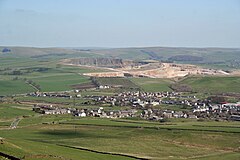Dove Holes
| Dove Holes | |
|---|---|
 Dove Holes from Combs Moss |
|
| Dove Holes shown within Derbyshire | |
| OS grid reference | SK074781 |
| Civil parish | |
| District | |
| Shire county | |
| Region | |
| Country | England |
| Sovereign state | United Kingdom |
| Post town | BUXTON |
| Postcode district | SK17 |
| Dialling code | 01298 |
| Police | Derbyshire |
| Fire | Derbyshire |
| Ambulance | East Midlands |
| EU Parliament | East Midlands |
| UK Parliament | |
Dove Holes is a village in the High Peak district of Derbyshire, England. It has a population of about 1,200 (2001) shown in the 2011 as being included in the population of Chapel-en-le-Frith. It straddles the A6 road approximately three miles north of Buxton and three miles south of Chapel-en-le-Frith. Trains run from Dove Holes railway station into Manchester.
Residents of the village live either in the village or on outlying farms. There are around six farms in the village and many more within the boundaries of the parish. There are also large limestone quarries that, over the years, have made an important contribution to the development and economy of the village. Additionally, there are several businesses. There are two public houses, one of which offers accommodation. There is a daily milk delivery service and a mobile library every fortnight. There is a church, Methodist chapel and a community centre. The village lies on the fringe of the Peak District National Park.
Evidence of human occupation at Dove Holes can be traced back to the Neolithic Period (late Stone Age) because of the existence of a henge, known locally as The Bull Ring, and an adjoining tumulus. In medieval times the area was used as the royal hunting Forest of High Peak (now known as Peak Forest), an area set aside as a royal hunting forest. The village's name is believed to derive from the Celtic word dwfr (dŵr in modern Welsh), which means water, hence Water Holes or Dove Holes. The same word is the origin of the name 'Dover' for the famous Channel ferryport.
...
Wikipedia

